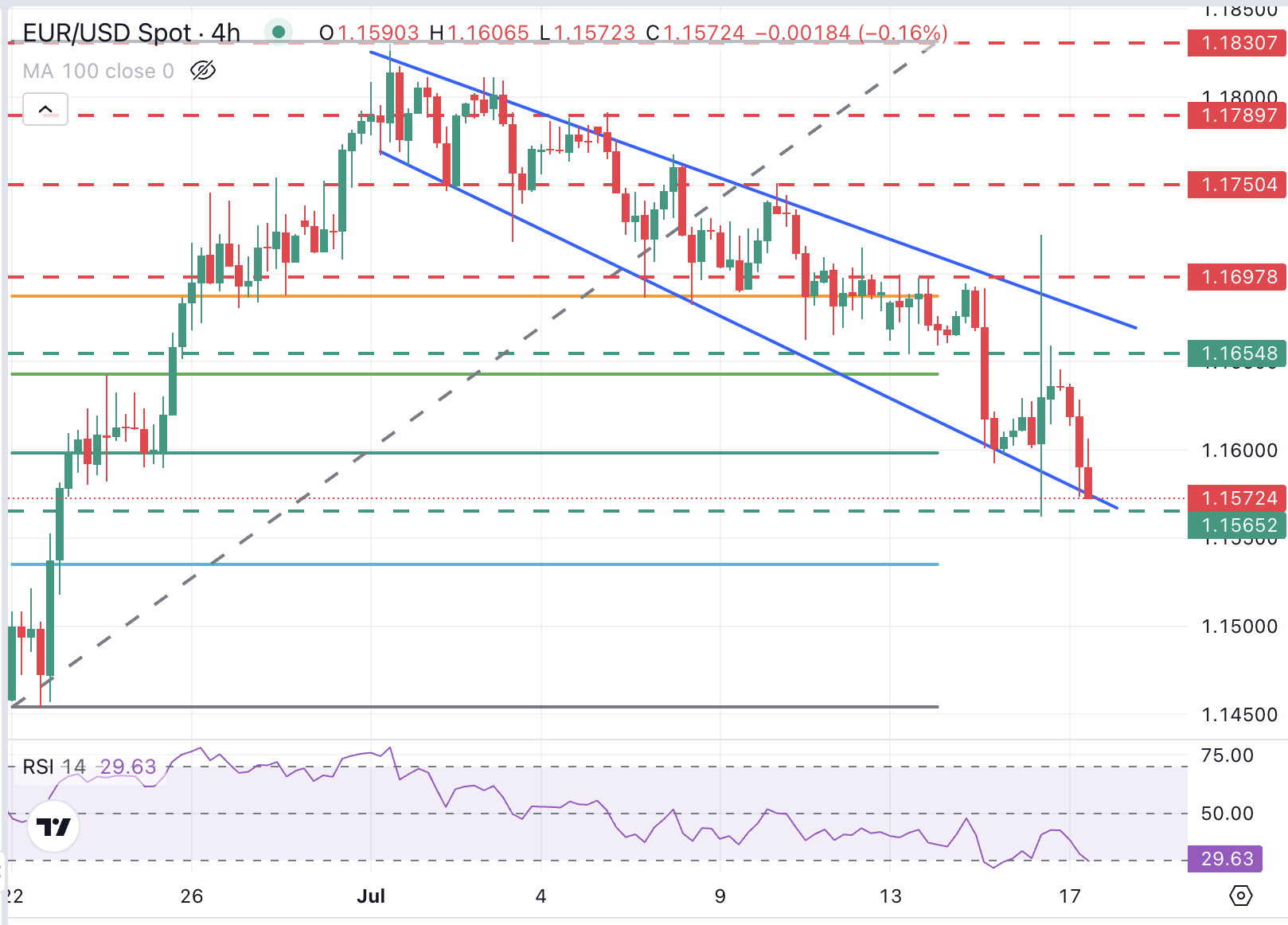- The euro shows a growing bearish impulse while investors prepare for US consumption and employment data.
- The speculation about the resignation of the president of the Fed, Powell, triggered a security search on Wednesday.
- The EUR/USD goes back on Wednesday’s profits and approaches minimum of three weeks in 1,1565.
The Eur/USD He is quoting on Thursday, with the cautious markets after a turbulent session in the US on Wednesday, since the tensions between US president Donald Trump and he President of the Fed, Jerome Powell, intensified. The US dollar as a safe shelter is overcoming its peers on Thursday, while investors expect the US retail sales data and the figures of unemployment applications Weekly.
The euro (EUR) extended the losses in the European session on Thursday, reaching session minimums in 1,1575 at the time of writing and approaching at least three weeks in 1,1565. The general trend remains bassist, with the price action quoting at the bottom of the bearish trend channel from the maximum of 1,1830 of July 1.
President Trump calmed the operators on Wednesday, stating that he does not plan to say goodbye to Powell, since that would interrupt the market. However, he added that he would like him to resign, a possibility that was later denied by a federal reserve spokesman. Trump also suggested the possibility of saying goodbye to the president of the Fed due to excessive costs of the historic construction of the Central Bank in Washington, potentially due to fraud charges.
The ongoing tensions between Trump and Powell have raised speculation that the president of the Fed could be replaced by one more Dovish, which would bring greater inflation and, most likely, would erode the confidence of investors in the independence of the central bank and, more widely, in the US financial system.
In the macroeconomic front, the final figures of the Consumer Price Index (CPI) of the euro zone for June have confirmed the preliminary data. Inflation grew at a rate of 0.3% since June, and 2% year -on -year, slightly above the annual growth of 1.9% in May, but still in line with the aim of European Central Bank For price stability. The underlying IPC increased 0.4% in the month and 2.3% year -on -year, complying with preliminary estimates.
Euro price today
The lower table shows the percentage of euro change (EUR) compared to the main currencies today. Euro was the strongest currency against the Australian dollar.
| USD | EUR | GBP | JPY | CAD | Aud | NZD | CHF | |
|---|---|---|---|---|---|---|---|---|
| USD | 0.46% | 0.14% | 0.58% | 0.51% | 0.95% | 0.46% | 0.45% | |
| EUR | -0.46% | -0.31% | 0.10% | 0.08% | 0.52% | 0.03% | 0.02% | |
| GBP | -0.14% | 0.31% | 0.48% | 0.37% | 0.81% | 0.32% | 0.31% | |
| JPY | -0.58% | -0.10% | -0.48% | -0.11% | 0.32% | -0.13% | -0.15% | |
| CAD | -0.51% | -0.08% | -0.37% | 0.11% | 0.52% | -0.05% | -0.06% | |
| Aud | -0.95% | -0.52% | -0.81% | -0.32% | -0.52% | -0.58% | -0.50% | |
| NZD | -0.46% | -0.03% | -0.32% | 0.13% | 0.05% | 0.58% | -0.01% | |
| CHF | -0.45% | -0.02% | -0.31% | 0.15% | 0.06% | 0.50% | 0.01% |
The heat map shows the percentage changes of the main currencies. The base currency is selected from the left column, while the contribution currency is selected in the upper row. For example, if you choose the euro of the left column and move along the horizontal line to the US dollar, the percentage change shown in the box will represent the EUR (base)/USD (quotation).
What moves the market today: the euro fluctuates in rank before the IPC of the Eurozone and the US retail sales data.
- The culminating point during the European session is the IPC report of the June Eurozone, which is expected to confirm the preliminary figures that revealed an interannual growth of 2%, compared to 1.9% in May. The underlying IPC was reported at 2.3% year -on -year in preliminary reading, without changes compared to May.
- In the US, retail sales are expected to increase 0.1% in June, after a contraction of 0.9% in May. Excluding cars, the sales of all other products are expected to increase 0.3% after a contraction of 0.3% in May.
- Beyond that, unemployment applications are expected to have increased to 235K from 227K the previous week. The US dollar needs low solid requests and consumption data to relieve concerns about tariffs and support the “highest longer” posture of the Fed Powell on interest rates.
- On Wednesday, the data of the US Labor Statistics Office revealed that the US Production Price Index (IPP) stagnated in June, with the year -on -year rate decreasing to a 2.3% growth from 2.6% in May. Likewise, the underlying IPP remained flat in the month and the annual rate was moderated to 2.6% from 3% of the previous month. These figures calmed the fears of a resurgence of inflation, which were triggered by the Tuesday IPC report.
- Also on Wednesday, the Eurozone data showed that the commercial surplus of the region expanded far beyond expectations in May, increasing to 16,200 million euros from 9.9 billion euros in the previous month, exceeding the expectations of a more moderate surplus of 13,000 million euros.
- Italian CPI data has shown that inflation accelerated to 1.8% in the last 12 months until June, from the previous 1.7%. These figures are still below the 2% target of the European Central Bank (ECB), and therefore, the impact on the euro has been marginal.
EUR/USD is eroding the trend line support in 1,1570

EUR/USD He is resuming his broader bassist trend in the early European session on Thursday. The torque is testing the support area between the support line of support, now in 1,1570, and the minimum of Wednesday in 1,1565. The 4 -hour RSI is low but is not yet at overall levels, suggesting that greater depreciation is likely.
Below, the euro could find support in the recoil of Fibonacci of 78.6% of the upward race of the end of June in 1,1535, in the area where the bulls were limited on June 20. Below here, the minimums of June 19 and 23 around 1,1455 seem too distant objective for today.
On the positive side, the immediate resistance is in the anterior support area of 1,1655 (minimums of July 11 and 14). Above, there is the upper part of the channel in 1,1680 and the maximums of July 14 and 15 just below 1,1700.
Economic indicator
Retail sales (MOM)
This survey of goods sold by retail merchants publishing the Census Bureau It is based on a sample of retail stores of different types and is considered an indicator of the economy growth rate. It shows the performance of the retail sector in the short and medium term. A result superior to the market consensus is bullish for the dollar, while a lower result is bassist.
Read more.
Next publication:
Jul 17, 2025 12:30
Frequency:
Monthly
Dear:
0.1%
Previous:
-0.9%
Fountain:
US Census Bureau
Retail Sales Data Published by The US Census Bureau is a leading indicator that Gives Importion Information about consumer spending, which has a significant impact on the GDP. Although Strong Sales Figures Are Likely to Boost The USD, External Factors, Such As Weather Conditions, Could Distort The Data and Paint A Misleading Picture. IN ADDITION TO THE HEADLINE DATA, CHANGES IN THE RETAIL SALES CONTROL GROUP COULD TRIGGER A MARKET REACTION AS IT IS USED TO PREPARE THE ESTIMATES OF PERSONAL CONSUMPTION EXPECTURES FOR MOST GOODS.
Economic indicator
Weekly Petitions of Unemployment Subsidy
Weekly unemployment subsidy requests are published by the US Department of Labor And it is a measure of the number of people who have asked for their first unemployment insurance application. In other words, it provides a measure of strength in the labor market. A higher number of anticipation indicates weakness in the labor market, which influences the strength and direction of American economic activity. In this way, a reading lower than expected is bullish for the dollar.
Read more.
Next publication:
Jul 17, 2025 12:30
Frequency:
Weekly
Dear:
235K
Previous:
227K
Fountain:
US Department of Labor
Every Thursday, the US Department of Labor publishes the number of initial applications for unemployment benefits of the previous week in the US, since this reading could be very volatile, investors can pay more attention to the average of four weeks. An bearish trend is considered a sign of an improvement in the labor market and could have a positive impact on the performance of the USD in front of its rivals and vice versa.
Source: Fx Street
I am Joshua Winder, a senior-level journalist and editor at World Stock Market. I specialize in covering news related to the stock market and economic trends. With more than 8 years of experience in this field, I have become an expert in financial reporting.







